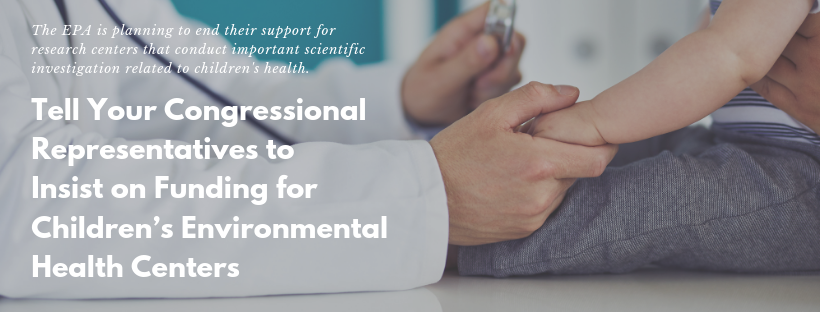28
May
Take Action: Protect Funding for Children’s Environmental Health
 (Beyond Pesticides, May 28, 2019) In yet another attack by the Trump administration on science, public health, and children and families, as well as another wink and nod to industries whose products harm, the U.S. Environmental Protection Agency (EPA) and the National Institute of Environmental Health Sciences (NIEHS) are planning to end their support for research centers that do important scientific investigation related to children’s health.
(Beyond Pesticides, May 28, 2019) In yet another attack by the Trump administration on science, public health, and children and families, as well as another wink and nod to industries whose products harm, the U.S. Environmental Protection Agency (EPA) and the National Institute of Environmental Health Sciences (NIEHS) are planning to end their support for research centers that do important scientific investigation related to children’s health.
EPA has announced that it will no longer renew its grants to these centers. As of July, they will lose a huge portion of the funding that has allowed them to deploy hundreds of scientists — in genetics, toxicology, and neurodevelopment — on unusually comprehensive and longitudinal studies of what factors in children’s experiences and communities impact their health. The work of these centers has been critical in uncovering the relationships between children’s exposures to toxic chemicals, including pesticides, and diseases and health anomalies later on in their developing years.
According to Tracey Woodruff, PhD, who runs the University of California, San Francisco Pregnancy Exposures to Environmental Chemicals Children’s Center: When EPA weighs the harms of a chemical against its benefits, ignorance “works out perfectly for industry. . . If EPA doesn’t know, it counts for zero.” The centers are very concerned that EPA’s withdrawal of support will force them to stop important, long-term research projects.
The studies conducted by these centers often begin before birth and follow subjects through childhood and into adulthood, yielding unusually rich data that can track, for example, environmental exposures early in life and subsequent and related health problems years later. In addition, these longitudinal studies can adapt to the changing mixes of exposure risks children may face over 20 years or so as they grow from newborns to young adults. Ruth Etzel, MD, a pediatrician at EPA specializing in children’s environmental health, notes, “Twenty years ago, what we were studying is not the same as what we’re studying today. We have to study children now, in their communities.”
During the past 20+ years, centers have operated in California, Colorado, Illinois, Michigan, Iowa, Ohio, Georgia, North Carolina, Maryland, New Jersey, New York, Rhode Island, Massachusetts, and New Hampshire, often producing results that lead to reform in policies and practices, and ultimately, improved health outcomes.
The withdrawal of funding by EPA will likely mean reductions in such programs, and such losses may put at risk both the health of neighboring communities and the relationships the research centers have built with them. Pediatricians and researchers find the work of the centers to be critical for communities. NIEHS has said it is unable, without significant changes to the centers’ programs, to make up the shortfall caused by EPA’s abandonment of grant support for the centers — the agency is trying to capitalize on the research the centers have completed by supporting their community outreach, and is searching for ways to keep study cohorts together going forward.
Letter to Congress
I am writing to ask you to insist on continuation of government funding for university-based Children’s Environmental Health Centers. The Trump Administration’s Environmental Protection Agency (EPA) and National Institute of Environmental Health Sciences (NIEHS) are planning to end their support for research centers that do important scientific investigation related to children’s health.
The studies conducted by these centers often begin before birth and follow subjects through childhood and into adulthood, yielding unusually rich data that can track, for example, environmental exposures early in life and subsequent and related health problems years later. In addition, these longitudinal studies can adapt to the changing mixes of exposure risks children may face over 20 years or so as they grow from newborns to young adults. Ruth Etzel, MD, a pediatrician at EPA specializing in children’s environmental health, notes, “Twenty years ago, what we were studying is not the same as what we’re studying today. We have to study children now, in their communities.”
During the past 20+ years, centers have operated in California, Colorado, Illinois, Michigan, Iowa, Ohio, Georgia, North Carolina, Maryland, New Jersey, New York, Rhode Island, Massachusetts, and New Hampshire, often producing results that lead to reform in policies and practices, and ultimately, improved health outcomes. Examples include:
* A University of Southern California center study of air pollution connections to obesity and poor health that resulted in state and federal guidelines to improve air quality standards and urban planning decisions, including restrictions on building of schools near major roads.
* The Children’s Environmental Health and Disease Prevention Research Center at Dartmouth College discovered that infants who ate rice products had higher urinary levels of arsenic; this led to a proposed FDA (Food and Drug Administration) limit on inorganic arsenic in infant rice cereals.
* The Children’s Environmental Health Center at Mount Sinai (Icahn School of Medicine) Institute for Exposomic Research found prenatal exposure to organophosphates to be negatively associated with children’s cognitive development (particularly perceptual reasoning) as early as age 12 months, and continuing through early childhood.
* The Columbia Center for Children’s Environmental Health reported in 2012 on research showing that children exposed to high levels of chlorpyrifos prenatally had lower IQs and altered brain structure compared to those with low exposures.
Please insist on funding for the Children’s Environmental Health Centers.
Thank you.











protect kid’s health by protecting the environment.
May 28th, 2019 at 2:22 pm